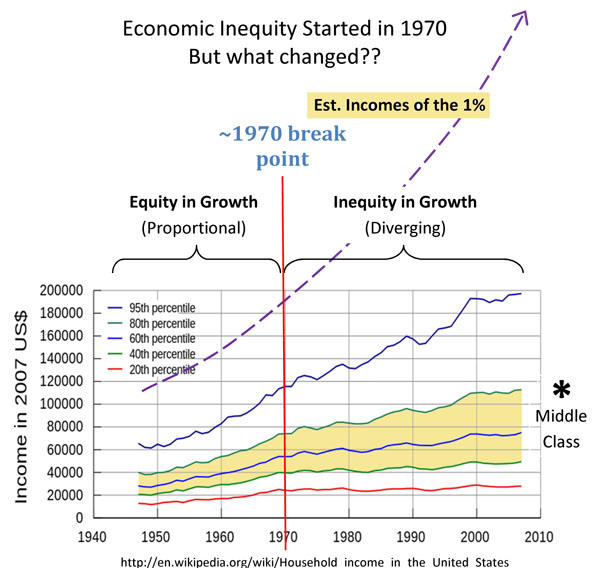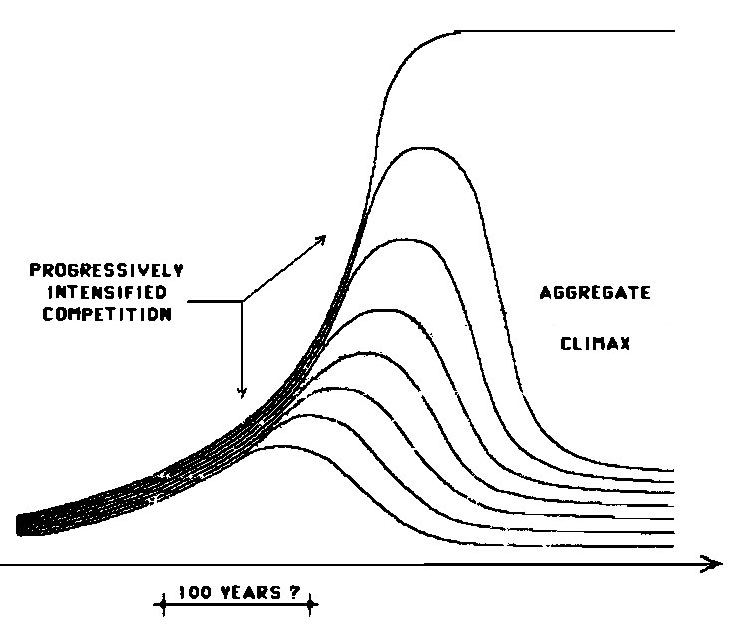It helps to look at the long term trends to recognize the long term pattern.
In a world of ever increasing inequities we clearly can’t sustain a real “rights agenda”. Even the strongest of moral commitments is no match for a world economy which in a lasting physical way, is systematically splitting apart.
Sometimes local inequities can seem to be blamed on local conditions, but not when it’s a long sustained accelerating global trend. That’s what we see in this US data from 2008, showing that growing inequity in household income has been a very persistent trend. It’s a very familiar subject of discussion and increasing complaint too, that ever increasing shares of the wealth are going to the wealthy. It’s been a central motivation for the UN’s debates on how achieve sustainable development too. So the trend as of 2008, if anything, has probably only been getting worse. Little is likely to change, either, with the SDG’s having no language for reversing the pattern of the wealthy being the only winners in the modern economy.
It’s the household incomes of everyone else that stopped growing.

showing US & Global GDP having continued to grow as before.
To understand the root cause you need to think about it as a symptom, a symptom of how the global economic system is behaving. The key piece of information is that “What is happening, is happening for the world economy as a whole”. Around ~1970 what happened to the US economy, as the bellwether for the world, is that the wealth of the wealthy kept growing exponentially, more or less just as before. Nothing else did.
The shape of the Data explains the operation of the system
Very little simplification is needed to say why this happened.
What connects all the parts is that the economy started to run into increasing complications
not of things running out, but of things of all kinds running up in cost.
Much of our economic news over the past decades has been about the struggle to keep up with the rising costs and complications of everything, and the evidence is that has become a gradual form of stiff natural limit. The real key to understanding the pattern is recognizing why rising costs would be faced by every part of the economy at once.
It’s that an economy works as a whole, all parts seeking least cost ways of doing everything,
and more expensive ways are not used unless there’s no alternative
The puzzle, still, is why the incomes of the wealthy would have grown exponentially in the first place, and then evidently be able to keep growing the same way as before, as the whole economy confronts increasing difficulties. That is the specific cause of the growing inequity.
It’s hard to find a simple explanation, but it’s as if the wealthy are able to require profits as before, from economies that are not producing them as before. The evidence seems to be that the long standard practice of the wealthy, of earning from investments and always adding their profits to their invested assets, to make their assets and incomes grow exponentially, continues uninterrupted. As the economy struggles ever harder against the complications of natural limits, the ability of the wealthy to demand and accumulate profits as before, gives them a decidedly unfair advantage.
If it could continue there would eventually be a point where the economy completely splits apart, as in the figure below. Unable to divert ever faster increasing wealth for the wealthy the economy would eventually stabilize in two tiers, rich and poor. That’s the real problem with any plan for limitless growth in a finite world. It results in tearing any society apart in the end. The concept of limitless growth with ever growing profits works fine by itself, of course, it’s just that a system managed to solve ever more complex problems, with the complications not taken into account ,will suffer and breaks down.
The Natural Pattern
The cause of the pattern is continually increasing competition in a finite world, creating winners and losers to the point where everyone becomes the loser in the end.

Research notes on what seem to the three main factors
- Systematically increasing resource costs with decreasing resilience and capacities
“The big Crunch” natural limits and the food crisis - Systemically increasing complexity creating information overload, and disinterest in complex subjects
Complexity too great to follow what’s happening… ?? - Shifting business decisions to computers programmed to use the single variable of “the bottom line”.
Computers taking over our jobs and our pay?
A draft introduction to a new scientific method for on recognizing and understanding systemic behavior patterns like these, so people trying to implement of the UN’s Sustainable Development Goals (SDG’s) can recognize the shifting economic/cultural/environmental forces they are dealing with.
4. A new “Natural Systems” approach to recognizing systemic behaviors
Interpreting “Big Data” exposing earth systems to guide the SDG’s
JLH Oct 2014
